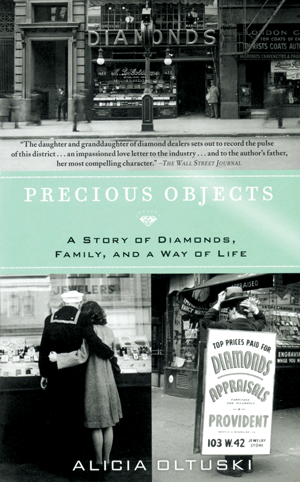Reviewed by NEAL GENDLER
Thanks to Alicia Oltuski, I learned more than I ever could have imagined about the diamond business — and the lessons were pure joy.
Precious Objects far exceeded my expectations. It is (forgive me) a gem. I hardly could put it down.
Oltuski, a writer and teacher, is the daughter of a diamond trader who specializes in old jewelry, for which there is more demand than I would have guessed. In her early 20s, she worked for her father, managing some of his paperwork and carrying his wares concealed in small packs between layers of clothing.
Oltuski will speak Nov. 4 as part of the Twin Cities Jewish Book Fair
Writing in the easy, economical style of a newspaper reporter, she covers just about every facet (excuse me again) of the still heavily Jewish industry: history, mining, rough stones, cutting, polishing, grading, diamond styles, trading and problems of burglary, non-payment and “blood diamonds.”

Another hazard is buying stones valued at five and six figures, only to have the market drop before they’re sold, creating huge losses. This happened widely in the recent recession; dealers were owed money they couldn’t collect and some closed.
“Over the ages, as Jews were linked with the diamond industry, Judaism became a worldwide business system in addition to a religion,” Oltuski says.
She focuses on New York’s 47th Street diamond district, where for decades Jews have bought, sold, haggled — often in Yiddish — and entrusted each other with jewels on consignment, sometimes without a receipt.
“In this business,” she says, “everything runs on credit, loan and trust.”
Oltuski believes “it was inevitable for a people who have faced obliteration so many times to make the most resilient material on earth their trademark commodity.” But there also was logistic sense: Diamonds have high value but are small enough to conceal and carry when fleeing.
By the end of 1940, she says, 1,500 diamond dealers had immigrated to New York, shifting the trade’s center from Antwerp and Amsterdam. Israel now is another center.
Deals still are concluded by handshake and mazel und brucha, Yiddish for “luck and blessing,” or simply mazel, and used by everyone including Indians — a growing part of the industry — and Muslims. Politics are one thing; business is another.
Oltuski weaves in her family’s history, starting with grandparents who fought the Nazis — he as a Soviet junior officer and she as a partisan. When fighting ended, Oltuski’s grandfather got into a dangerous spat and fled to Berlin, disappearing into the DP world. He traded a German some U.N.-supplied food for a diamond, the diamond for a BMW, and the car for 1,000 pairs of shoes he sold in one day. With the proceeds, he began trading diamonds around Europe.
Oltuski also traces the history of Ernest Oppenheimer’s giant De Beers company, how it manipulated consumer demand and how its ad agency created “one of the most cunning feats of marketing history” by equating diamonds with love and eternity in the phrase: “A diamond is forever.”
There’s now a second meaning. Oltuski describes man-made diamonds, cubic zirconium and a product called LifeGem — a diamond created from ashes or hair of the dead. You can wear your loved one, or your pet — or maybe even yourself — as jewelry.
Precious Objects is a gold mine of “who knew?” facts, including that diamonds are sorted into about 12,000 categories. Jewelry criteria include color, clarity, weight and cut.
Precious Objects has extensive source notes and a large bibliography although, alas, no index. Good typography makes for strain-free reading. Annoyingly, Oltuski often uses “their” for singular nouns — a fingernails-on-blackboard mistake that an experienced writer shouldn’t make and a competent editor should fix.
Ignore that, and this book is a jewel.
***
Neal Gendler is a Minneapolis writer and editor.
Alicia Oltuski will talk about Precious Objects as part of the Twin Cities Jewish Book Fair 7 p.m. Sunday, Nov. 4 at the St. Paul JCC, 1375 St. Paul Ave.
(American Jewish World, 10.26.12)



















